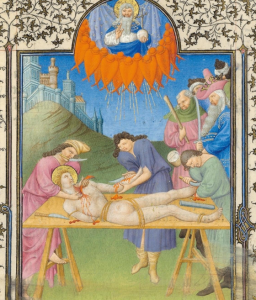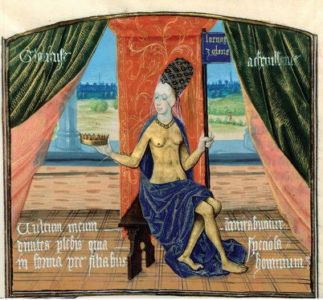You know, this was probably the first lecture I’ve been to which has asked me to pay particularly close attention to artistic representations of Christ’s nipples! Or which included the phrase “transgressive sado-erotic response to sacred nudity.” Art historians clearly have all the fun! Prof. Sherry Lindquist’s lecture, “The Rhetoric of the Flesh in Late Medieval Art”, was a really fascinating look at how medieval artists used depictions of nudity to represent complex theological ideas, their patron’s piety and sensuality, or their own sense of themselves as artists.
Lindquist examined three different manuscripts. The first, Louis of Bruges’ “Twelve Ladies of Rhetoric” (BnF fr1174), depicts the eponymous ladies performing a variety of artisans—except for the last lady, Glorious Achievement, pictured above. Now, when I first saw that image, I thought Glorious Achievement was a medieval argument against the perils of sun exposure, but she is apparently actually dressed in a skin-tight gold garment which is used to make her nudity even more titillating. Glorious Achievement is also hidden in earlier panels in the text, like a sort of medieval Where’s Wally, so getting to the end of the text sheds a new light on all the previous pages which the reader has looked at.
 The next text examined was the Belles Heures of the Limbourg Brothers, a manuscript which depicts the human form in some idiosyncratic ways which don’t occur in the brothers’ earlier or later works. Lindquist identified a contrast between the suffering, unclothed bodies of the martyrs here being contrasted with sinful, tempting and clothed bodies. There’s something very interesting going on there, particularly in the scenes showing the torture of St Bartholmew (pictured right) and also Christ’s scourging at the pillar. I was fascinated by how the Bartholomew scene in particular invites the viewer’s complicity—the knife lying waiting for someone to take it up, the voyeurism of watching the dismemberment of Bartholomew’s naked body, the sheer gusto with which the torturers approach their task. Lindquist pointed out that when later medieval artistis copied this image—which they often did quite faithfully by tracing—they tended to omit those elements. There’s something going on here, some aspect of skin as a marker of identity (of sexuality?) that the Limbourgs seem to be working through here. Perhaps, Lindquist suggests, this is a reflection of the patron who commissioned this work, Jean duc de Berry, whose homosocial tendencies were the subject of much gossip during his lifetime.
The next text examined was the Belles Heures of the Limbourg Brothers, a manuscript which depicts the human form in some idiosyncratic ways which don’t occur in the brothers’ earlier or later works. Lindquist identified a contrast between the suffering, unclothed bodies of the martyrs here being contrasted with sinful, tempting and clothed bodies. There’s something very interesting going on there, particularly in the scenes showing the torture of St Bartholmew (pictured right) and also Christ’s scourging at the pillar. I was fascinated by how the Bartholomew scene in particular invites the viewer’s complicity—the knife lying waiting for someone to take it up, the voyeurism of watching the dismemberment of Bartholomew’s naked body, the sheer gusto with which the torturers approach their task. Lindquist pointed out that when later medieval artistis copied this image—which they often did quite faithfully by tracing—they tended to omit those elements. There’s something going on here, some aspect of skin as a marker of identity (of sexuality?) that the Limbourgs seem to be working through here. Perhaps, Lindquist suggests, this is a reflection of the patron who commissioned this work, Jean duc de Berry, whose homosocial tendencies were the subject of much gossip during his lifetime.
Lastly, Prof. Lindquist looked at the “Hours of the Earls of Ormond” (BL Harley 2887), which is an interesting look at how medieval artists addressed the thorny issue of how to depict the Trinity. All parts of the Trinity are supposed to be co-equal, and yet Christ became incarnate and the Holy Spirit is often referred to or depicted metaphorically/symbolically.
This leads to a rather delightfully strange series of depictions of the Trinity in this manuscript: the Trinity is depicted several times in the same basic composition—as seen to the left in f. 33v—where all three figures are shown nude from the waist up, the sun’s rays emanating from them. In all of the images, Christ is shown with pale, “human” flesh, while God and the Holy Spirit are shown with golden flesh (echoes of Glorious Achievement’s depiction). In all, the Trinity is crowned and holding a book. Yet in some of the images, their hand gestures are different; in some, only Christ has legs while in others all three figures do; in some, only Christ has a belly button and nipples (products of the Incarnation), while in others all three figures do. I’m not sure that it’s possible for us, at this remove, to be able to understand the artist’s motivation in providing such different representatons of the Trinity all within the same text, but the process of speculation is surely fascinating!
